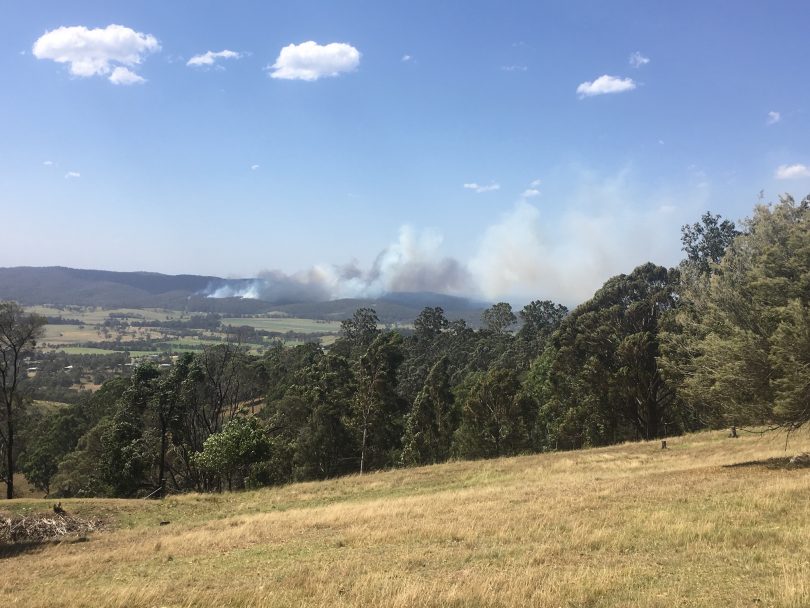
The early stages of the 2018 bushfire that destroyed 65 homes, as seen from Black Range. Photo: Ian Campbell.
Several survivors of the Tathra region’s bushfire are suing Essential Energy, arguing it had been a long-dead tree near one of the electricity corporation’s power lines that had fallen and sparked the blaze that devastated their region.
The Tathra and Reedy Swamp Bushfire on 18 March, 2018, destroyed 65 homes, damaged a further 39, covered about 1400 hectares and was not extinguished for about a week.
Firefighters saved 810 homes, while Tathra residents were forced to seek refuge at the town’s beach or in Bega.
Four locals have now launched civil proceedings against the NSW Government-owned Essential Energy, as well as a contractor and subcontractor, over their losses from the blaze.
The fire began in Reedy Swamp in dry sclerophyll forest where a corridor had been cleared for power lines operated by Essential Energy, the NSW Supreme Court heard during the matter’s opening submissions on Monday (19 February).
Near a power line in the corridor was a “long-dead” mature eucalypt, believed to be a silvertop ash, that had been labelled Tree Four, the plaintiffs’ barrister Lachlan Armstrong KC said.
It had been 37 degrees Celsius on 18 March, 2018, with wind speeds of 40 km/h and gusts of around 60 km/h.
The barrister claimed that as the strong winds buffeted the forest at 12:19 pm, Tree Four, which had been estimated to be about 21 metres tall, fell. It hit the power line, ripped a conductor off a pole, then drove it into the ground.
The conductor allegedly began arcing as it landed, drying out vegetation, then either the arcs or sparks set this material on fire.
Mr Armstrong said the flames spread under the wind, moving up the hill and east. By 3 pm it jumped the Bega River, by 3:30 pm it began impacting Tathra, by 4:15 pm the town was fighting spot fires, and then it reached Tathra Beach by 5:45 pm.
The barrister said Essential Energy’s regulatory framework required it to develop extensive procedures for managing the risks of faults in its network, including making clearance zones around conductors and managing vegetation.
He also said there were two types of vegetation hazards. Tier one comprised trees that were a few metres from a powerline, while tier two was those outside a clearance space, but could be at risk of falling into that space. Tree Four was a tier-two hazard, he said.

Thompson Drive in Tathra felt the full force of the flames on 18 March, 2018. Photo: David Neyle.
The barrister said a “very live question” in the hearing was what vegetation might have obscured a view of Tree Four from workers maintaining the area, but he argued the evidence would show it wouldn’t have impeded the tree’s visibility.
He also said while the problems some trees had were subtle, “Tree Four’s problems were not subtle”.
Experts would suggest this tree had been dead for about five years, he said. He claimed it had been bending towards the cleared corridor, its heavier limbs were likely to have been weighted towards the easement, it had developed splits through its length and was metres inside the notational edge of the corridor.
In addition, silvertop ashes don’t have deep root systems and become unstable when they die.
Mr Armstrong argued that due to the tree’s problems, a properly trained inspector should have been able to recognise the risk it posed.
However, he claimed Essential Energy failed to undertake basic checks to ascertain whether personnel authorised for scoping works had been adequately trained. Also, an expert would claim the managers for scoping staff had not been trained enough to ensure their scopers were conducting enough checks for tier-two hazard trees.
The court heard Essential Energy said it hadn’t planted Tree Four and was not the landowner of the site, but its lawyers did not make opening submissions on Monday and will instead present their case over the coming weeks.
The four listed plaintiffs are Alexis Creary, Tathra Beach Motor Village, Janet Harris and Phillip Rowland. Mr Armstrong said they had been chosen as “four test-case plaintiffs” as they were covered by different insurers, were in different locations at the start of the fire and suffered different kinds of losses.
The other defendants are Essential Energy’s contractor, Asplundh Tree Expert (Australia), and the latter’s subcontractor, Pinnacle Arborpro.
The hearings are listed to run until 15 March before Justice Julia Lonergan.








